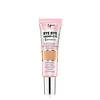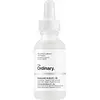IT Cosmetics Bye Bye Undereye Illumination Full Coverage Anti-Aging Waterproof Concealer Versus The Ordinary Hyaluronic Acid 2% + B5
What's inside
What's inside
 Key Ingredients
Key Ingredients

 Benefits
Benefits

 Concerns
Concerns

 Ingredients Side-by-side
Ingredients Side-by-side

Caprylic/Capric Triglyceride
MaskingBis-Diglyceryl Polyacyladipate-2
EmollientVp/Hexadecene Copolymer
Cetyl Alcohol
EmollientSilica Dimethyl Silylate
EmollientMicrocrystalline Wax
Emulsion StabilisingPhenoxyethanol
PreservativeNiacinamide
SmoothingSodium Hyaluronate
HumectantMagnesium Ascorbyl Phosphate
AntioxidantTocopheryl Acetate
AntioxidantAscorbyl Palmitate
AntioxidantHydrolyzed Collagen
EmollientWater
Skin ConditioningPentaerythrityl Tetra-Di-T-Butyl Hydroxyhydrocinnamate
AntioxidantCholesteryl Isostearate
EmollientCholesteryl Chloride
Skin ConditioningCholesteryl Nonanoate
EmollientGlycerin
HumectantSteareth-20
CleansingSilica
AbrasiveChlorhexidine Digluconate
AntimicrobialN-Hydroxysuccinimide
Skin ConditioningBHT
AntioxidantSodium Citrate
BufferingPotassium Sorbate
PreservativePalmitoyl Tripeptide-1
Skin ConditioningChrysin
Skin ConditioningPalmitoyl Tetrapeptide-7
Skin ConditioningCitric Acid
BufferingBiotin
AntiseborrhoeicTitanium Dioxide
Cosmetic ColorantIron Oxides
Mica
Cosmetic ColorantCaprylic/Capric Triglyceride, Bis-Diglyceryl Polyacyladipate-2, Vp/Hexadecene Copolymer, Cetyl Alcohol, Silica Dimethyl Silylate, Microcrystalline Wax, Phenoxyethanol, Niacinamide, Sodium Hyaluronate, Magnesium Ascorbyl Phosphate, Tocopheryl Acetate, Ascorbyl Palmitate, Hydrolyzed Collagen, Water, Pentaerythrityl Tetra-Di-T-Butyl Hydroxyhydrocinnamate, Cholesteryl Isostearate, Cholesteryl Chloride, Cholesteryl Nonanoate, Glycerin, Steareth-20, Silica, Chlorhexidine Digluconate, N-Hydroxysuccinimide, BHT, Sodium Citrate, Potassium Sorbate, Palmitoyl Tripeptide-1, Chrysin, Palmitoyl Tetrapeptide-7, Citric Acid, Biotin, Titanium Dioxide, Iron Oxides, Mica
Water
Skin ConditioningSodium Hyaluronate
HumectantPentylene Glycol
Skin ConditioningPropanediol
SolventSodium Hyaluronate Crosspolymer
HumectantPanthenol
Skin ConditioningAhnfeltia Concinna Extract
Skin ConditioningGlycerin
HumectantTrisodium Ethylenediamine Disuccinate
Citric Acid
BufferingIsoceteth-20
EmulsifyingEthoxydiglycol
HumectantEthylhexylglycerin
Skin ConditioningHexylene Glycol
Emulsifying1,2-Hexanediol
Skin ConditioningPhenoxyethanol
PreservativeCaprylyl Glycol
EmollientWater, Sodium Hyaluronate, Pentylene Glycol, Propanediol, Sodium Hyaluronate Crosspolymer, Panthenol, Ahnfeltia Concinna Extract, Glycerin, Trisodium Ethylenediamine Disuccinate, Citric Acid, Isoceteth-20, Ethoxydiglycol, Ethylhexylglycerin, Hexylene Glycol, 1,2-Hexanediol, Phenoxyethanol, Caprylyl Glycol
 Reviews
Reviews

Alternatives
Ingredients Explained
These ingredients are found in both products.
Ingredients higher up in an ingredient list are typically present in a larger amount.
Citric Acid is an alpha hydroxy acid (AHA) naturally found in citrus fruits like oranges, lemons, and limes.
Like other AHAs, citric acid can exfoliate skin by breaking down the bonds that hold dead skin cells together. This helps reveal smoother and brighter skin underneath.
However, this exfoliating effect only happens at high concentrations (20%) which can be hard to find in cosmetic products.
Due to this, citric acid is usually included in small amounts as a pH adjuster. This helps keep products slightly more acidic and compatible with skin's natural pH.
In skincare formulas, citric acid can:
While it can provide some skin benefits, research shows lactic acid and glycolic acid are generally more effective and less irritating exfoliants.
Most citric acid used in skincare today is made by fermenting sugars (usually from molasses). This synthetic version is identical to the natural citrus form but easier to stabilize and use in formulations.
Read more about some other popular AHA's here:
Learn more about Citric AcidGlycerin is already naturally found in your skin. It helps moisturize and protect your skin.
A study from 2016 found glycerin to be more effective as a humectant than AHAs and hyaluronic acid.
As a humectant, it helps the skin stay hydrated by pulling moisture to your skin. The low molecular weight of glycerin allows it to pull moisture into the deeper layers of your skin.
Hydrated skin improves your skin barrier; Your skin barrier helps protect against irritants and bacteria.
Glycerin has also been found to have antimicrobial and antiviral properties. Due to these properties, glycerin is often used in wound and burn treatments.
In cosmetics, glycerin is usually derived from plants such as soybean or palm. However, it can also be sourced from animals, such as tallow or animal fat.
This ingredient is organic, colorless, odorless, and non-toxic.
Glycerin is the name for this ingredient in American English. British English uses Glycerol/Glycerine.
Learn more about GlycerinPhenoxyethanol is a preservative that has germicide, antimicrobial, and aromatic properties. Studies show that phenoxyethanol can prevent microbial growth. By itself, it has a scent that is similar to that of a rose.
It's often used in formulations along with Caprylyl Glycol to preserve the shelf life of products.
Sodium Hyaluronate is hyaluronic acid's salt form. It is commonly derived from the sodium salt of hyaluronic acid.
Like hyaluronic acid, it is great at holding water and acts as a humectant. This makes it a great skin hydrating ingredient.
Sodium Hyaluronate is naturally occurring in our bodies and is mostly found in eye fluid and joints.
These are some other common types of Hyaluronic Acid:
Learn more about Sodium HyaluronateWater. It's the most common cosmetic ingredient of all. You'll usually see it at the top of ingredient lists, meaning that it makes up the largest part of the product.
So why is it so popular? Water most often acts as a solvent - this means that it helps dissolve other ingredients into the formulation.
You'll also recognize water as that liquid we all need to stay alive. If you see this, drink a glass of water. Stay hydrated!
Learn more about Water